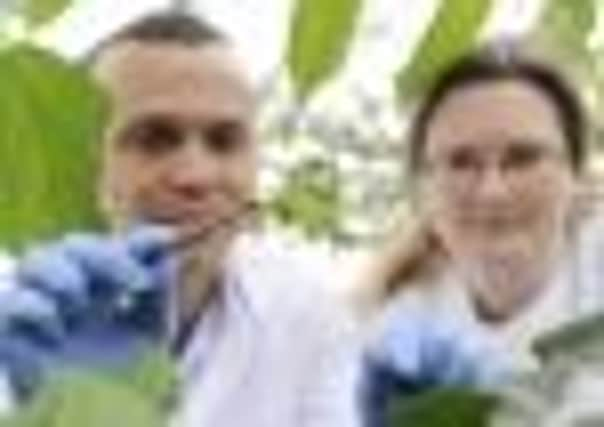DNA sleuth to help Brazil catch loggers


Now help is at hand from a Scottish botanist 6,000 miles from the South American crime scene investigation.
Brazilian police officers have arrived in Scotland to meet Professor Pete Hollingsworth, a world expert on horticultural DNA at Edinburgh Royal Botanic Garden, whose innovative techniques in identifying genetic material from plants could help convict the illegal traffickers behind the Amazon’s environmental crime wave.
Advertisement
Hide AdAdvertisement
Hide AdHollingsworth, science director at ERBG, has pioneered a “barcoding” process that can analyse plant DNA and determine if it comes from an endangered species.
“A major application of DNA barcoding in forensics is in the identification of plant products that are being illegally traded,” said Hollingsworth. “Many plants are protected from international trade, but it can be extremely difficult to identify whether a product comes from a protected or unprotected species.
“As DNA barcoding offers a means of doing this, there is great interest globally in developing a reference library to improve identification of protected species in trade.”
The DNA extraction process involves grinding up suspect plant samples and comparing them to known examples, and can help identify cut and crafted timber from illegal sources.
Illegal logging is on the increase in Brazil, which is home to a number of protected tree species. Criminal gangs working in the Amazon rainforest fell the trees to satisfy a black market for the wood both in Brazil and abroad. It is a lucrative business for the loggers, who can sell the wood for a single violin bow that is later sold on for several thousand pounds.
Recently several violins were recovered which police believe had been made from brazilwood – or pau brasil – an endangered tree that gave Brazil its name.
While DNA collected from people and animals has revolutionised police investigations worldwide, obtaining and identifying genetic material from plants to provide hard evidence to help convict criminals is far more complex.
Renato Paranaiba, a forensics expert with the Brazilian Federal Police, is one of the officers in Edinburgh to learn plant DNA extraction techniques from Hollingsworth.
Advertisement
Hide AdAdvertisement
Hide Ad“I am used to working with bones more than plants, but over the past few years there has been a move to combat environmental crime here, focused on the Amazonian regions,” he said. “Our government wants to do more to combat this crime and we have permanent environmental crime operations now in Brazil but although human and animal DNA is established in our police work we know little about plant DNA, so this is all new for me. We want to join the vanguard and this lab at the Botanics is the most respected around the world.”
Paranaiba has first-hand knowledge of the frustration experienced by the authorities when they know a crime has been committed but lack the evidence to prosecute.
“In May, police seized violins found in sheds in the state of Minas Gerais which we believed were made from Brazilian rosewood, another protected tree. But the techniques and traditional skills available to us could not give a conclusive result about the wood so we could not get a conviction. Plant DNA holds a promise for the future to help us identify species to prove that they are protected,” he said.
Dr Laura Forrest, who works with Hollingsworth, explained how DNA kits are used to identify seized plant material. Each sample is ground to a powder and placed in a tube with a “buffer” solution. It is then spun in a centrifuge to separate out any DNA in the form of pellets or strands. These are then suspended in a gel where the DNA’s naturally negative electrical charge causes it to spread out to form a distinctive pattern, or barcode, showing the genetic sequences, which can be compared to known plant samples.
“Unlike animal cells, plant cells have walls which we have to break down to obtain the DNA,” said Forrest. “Barcoding can tell us a great deal more than trying to identify plants by looking at their physical form because there are so many different species of plant which look very similar.
“We have been working with samples that are well cared for and kept in silica gel to keep moisture out, whereas the samples police analyse are often badly degraded, making them harder to work with.”
Helping the police is a far cry from her current work using DNA barcoding to create a reference library of UK liverworts – ancient plants which have been found in fossils dating back 470 million years. The project has proved how useful barcoding can be, by revealing that identical-looking liverworts found everywhere from the Arctic to Panama were actually distinct species. Experts around the world are also working on a “barcode of life” project to create a reference library of life on Earth which aims to produce five million barcodes from 500,000 species by 2015.
Hollingsworth hopes collaboration with Brazil’s police and scientists will help create a barcode library for endangered plant species.
Advertisement
Hide AdAdvertisement
Hide Ad“We are looking forward to developing this collaboration to enhance the enforcement of conservation legislation to improve the protection of plant species,” he said.